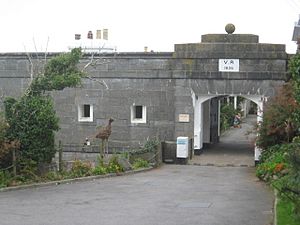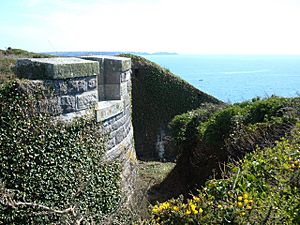Dale Fort facts for kids
Dale Fort is an old fort built in the mid-1800s. It sits on a rocky point called Dale Head, near Dale, Pembrokeshire in Wales. This fort was designed to protect the coast. Today, it's a special place run by the Field Studies Council. Students from schools and colleges come here to learn about nature and the environment. They can stay overnight or visit for the day. The fort also offers fun courses in natural history and art.
Contents
History of Dale Fort

People first thought about building a fort here in 1829. But the fort you see today was suggested in 1850. We don't know exactly when building started. However, it was finished by 1858. A stone above the main gate even says "1856".
Why Was Dale Fort Built?
The fort's main job was to protect the entrance to Milford Haven. It worked with other nearby forts, like Thorn Island and West Blockhouse. Together, their guns could create "interlocking fire." This meant their cannons could shoot at the same area, making it very hard for enemy ships to pass.
Later Uses of the Fort
In 1876, there was a plan to give the fort bigger, newer guns. But this never happened. In the 1890s, Dale Fort was used for testing a new type of weapon called the "Pneumatic Dynamite Gun." This gun used air to fire explosives, but it wasn't chosen for wider use.
In 1902, a military officer bought the fort and turned it into a home. After he passed away in 1925, the fort changed hands. During the Second World War, the navy took over the fort. They used it as a "degaussing" station. This process helped make ships less magnetic, protecting them from underwater mines (bombs). It was also a "mine-watching" station, where people looked out for enemy mines.
Dale Fort as a Study Centre
After the war, the fort was returned to its owner. In 1946, the West Wales Field Society bought Dale Fort. They then leased it to the Council for the Promotion of Field Studies. This group later became the Field Studies Council. In 1959, the Field Studies Council bought the fort themselves. Since then, Dale Fort has been a busy field centre. Thousands of students visit every year. Many of them are biology students who study the amazing plants and animals on the nearby coast.
What Dale Fort Looks Like
Dale Fort is built on the eastern end of a rocky point. To protect it from land attacks, there's a deep trench, or "ditch," cut into the rock. This ditch goes all the way across the point down to the water on both sides.
Defenses of the Fort
The side of the fort facing the ditch has a strong wall. This wall has "loopholes," which are small openings for soldiers to shoot through. In the middle of this wall is a "D"-shaped part called a "bastion." This bastion sticks out and has openings called "embrasures" for three guns.
In the northwest corner, there's a building with three sections. The middle section, facing the ditch, had guardrooms. The main entrance to the fort goes through here, after crossing the ditch by a bridge. The northern section was the "barracks," where ordinary soldiers slept. The southern section held various storage rooms.
Gun Battery and Other Areas
Further along the northern side, you would find the officers' quarters and the main "magazine." The magazine was where ammunition and gunpowder were stored safely. Today, a modern building for accommodation stands over the old magazine.
The main gun battery is at the eastern end of the fort, overlooking the water. There were seven spots for large "68-pounder guns." These guns fired "en barbette," meaning they were placed on open platforms and shot over a low protective wall called a "parapet." The four southernmost guns were on a higher level than the other three. There used to be a smaller magazine nearby to supply these guns, but it's gone now. The spot where the "Dynamite Gun" was tested is close to the fort's dining area today.



